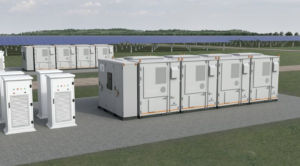Surging electric truck sales stall China’s LNG trucking boom – Institute for Energy Economics and Financial Analysis (IEEFA)

Report on the Electrification of China’s Heavy Vehicle Sector and its Impact on Sustainable Development Goals
Recent market data from China’s heavy-duty vehicle (HDV) sector indicates a significant and rapid shift towards electrification, a trend that directly supports the achievement of several United Nations Sustainable Development Goals (SDGs). This transition is characterized by surging sales of battery-electric trucks at the expense of liquefied natural gas (LNG) and diesel models, challenging previous forecasts for LNG demand in transportation.
Market Shift Analysis: The Rise of Electric HDVs
Sales Data and Market Penetration
Data from the first half of 2025 reveals a decisive move towards New Energy Vehicles (NEVs), primarily battery-electric models, in the heavy truck segment.
- Battery-electric models constituted 22% of all HDV sales in the first half of 2025, a substantial increase from 8.6% during the same period in 2024.
- In June 2025, NEV sales in the sector reached a monthly record of 18,007 units.
- Conversely, the market share for LNG-fueled HDVs declined from nearly 30% in 2024 to 26% in the first half of 2025.
- For two consecutive months, NEV sales have surpassed those of LNG vehicles, displacing an estimated one million barrels per day in implied diesel demand.
Contribution to SDG 13 (Climate Action) and SDG 11 (Sustainable Cities and Communities)
This rapid displacement of fossil fuels (diesel and LNG) with electricity represents a critical step in decarbonizing the transport sector. By reducing greenhouse gas emissions, this trend makes a direct and substantial contribution to SDG 13 (Climate Action). Furthermore, the reduction in tailpipe emissions improves air quality in urban centers and along major freight corridors, advancing the objectives of SDG 11 (Sustainable Cities and Communities).
Economic and Technological Drivers of Electrification
Cost-Effectiveness and Alignment with SDG 7 (Affordable and Clean Energy)
The transition is underpinned by compelling economic factors that align with SDG 7 (Affordable and Clean Energy). While LNG truck sales are highly sensitive to the narrowing price differential with diesel, electric alternatives are proving to be more resilient and cost-effective over their lifecycle.
- A report from the Institute for Energy Economics and Financial Analysis (IEEFA) found that the total cost of ownership for electric heavy trucks in China is 10% to 26% lower than for diesel models, despite higher upfront purchase costs.
- This advantage is driven by lower fuel (electricity) costs and the superior fuel economy of electric drivetrains.
- Favorable government purchase subsidies for electric models further incentivize the switch.
Innovation in Battery Technology and Infrastructure: Supporting SDG 9 (Industry, Innovation, and Infrastructure)
Technological advancements and the build-out of new infrastructure are accelerating the adoption of electric trucks, reflecting progress toward SDG 9 (Industry, Innovation, and Infrastructure). Battery swapping technology has emerged as a key enabler.
- Reduced Downtime: Battery swapping reduces refueling times to be comparable with diesel vehicles, thereby increasing truck utilization and profitability.
- Lower Capital Outlay: The technology shifts the high cost of the battery from the fleet operator to the battery station owner, significantly reducing the initial investment required to adopt electric trucks.
- Standardization: Companies like CATL are introducing standardized, swappable battery packs compatible with numerous truck models, removing a key barrier to adoption. CATL plans to deploy 300 heavy truck battery swap stations by the end of 2025.
Future Projections and Global Implications
Industry Adaptation and Sustainable Production (SDG 12)
Industry leaders are forecasting a profound market transformation, with Sany Group anticipating a 70% to 80% electric penetration rate by 2028. Notably, China’s leading LNG truck manufacturers are also among the top producers of electric models. This dual positioning allows them to pivot their product offerings seamlessly, facilitating a market-wide shift towards more sustainable production and consumption patterns, in line with SDG 12 (Responsible Consumption and Production).
Impact on Global Energy Markets
The electrification of China’s trucking fleet has significant global ramifications.
- Reduced LNG Demand: The trend severely curtails the long-term growth prospects for LNG in the transportation sector, a segment previously cited as a key driver of global LNG demand.
- Limited Impact on LNG Imports: China’s domestic LNG production capacity is sufficient to meet its transport sector’s needs, meaning the earlier LNG trucking boom had little impact on global LNG flows.
- Export of Sustainable Technology: As Chinese manufacturers expand exports of cost-competitive battery-electric trucks, other nations in Asia and beyond may be able to bypass an LNG transition phase and move directly to electrification, further advancing global climate and sustainability goals.
Analysis of Sustainable Development Goals (SDGs) in the Article
1. Which SDGs are addressed or connected to the issues highlighted in the article?
SDG 7: Affordable and Clean Energy
The article directly addresses the transition from fossil fuels (LNG and diesel) to cleaner energy sources (electricity) in China’s heavy-duty transportation sector. It highlights the increasing adoption of battery-electric trucks, which represents a shift towards cleaner energy solutions.
SDG 9: Industry, Innovation, and Infrastructure
The text focuses on industrial shifts and technological innovation. It details advancements in battery technology, such as battery swapping, and the development of new infrastructure, like CATL’s plan to deploy 300 battery swap stations. It also discusses how manufacturers are adapting their product lines to include electric models.
SDG 11: Sustainable Cities and Communities
The article implies a connection to this goal by discussing the expansion of battery swap networks into “16 city clusters nationwide.” The shift from diesel and LNG trucks to electric ones directly contributes to reducing air pollution in urban areas and along major transport corridors, making cities more sustainable.
SDG 12: Responsible Consumption and Production
The article highlights a significant change in consumption patterns for energy resources. The statement that electric trucks are “displacing over one million barrels per day in implied diesel demand” is a direct example of reducing the consumption of fossil fuels, aligning with the goal of more responsible resource use.
SDG 13: Climate Action
The core theme of the article—the transition from internal combustion engine trucks to battery-electric trucks—is a significant climate change mitigation strategy. By reducing reliance on fossil fuels like diesel and LNG in the high-emission heavy trucking sector, China is taking concrete action to lower its carbon footprint from transportation.
2. What specific targets under those SDGs can be identified based on the article’s content?
SDG 7: Affordable and Clean Energy
- Target 7.2: By 2030, increase substantially the share of renewable energy in the global energy mix. The article demonstrates progress towards this target by showing a significant increase in the market share of battery-electric heavy trucks, which run on electricity, a cleaner energy carrier than diesel or LNG.
- Target 7.3: By 2030, double the global rate of improvement in energy efficiency. The article notes that electric trucks have a lower total cost of ownership due to “lower fuel costs and higher fuel economy of battery-electric drives compared to internal combustion engines,” which points directly to improved energy efficiency.
SDG 9: Industry, Innovation, and Infrastructure
- Target 9.4: By 2030, upgrade infrastructure and retrofit industries to make them sustainable, with increased resource-use efficiency and greater adoption of clean and environmentally sound technologies and processes. The article provides clear examples, including the development of a “heavy-duty battery swapping network,” the introduction of standardized swappable battery packs, and manufacturers shifting production from LNG to electric models.
- Target 9.5: Enhance scientific research, upgrade the technological capabilities of industrial sectors… and encourage innovation. The article highlights innovations like CATL’s standardized “75#” battery pack, which is “compatible with 30 heavy truck models from a dozen manufacturers,” showcasing technological advancement and industry-wide collaboration.
SDG 11: Sustainable Cities and Communities
- Target 11.6: By 2030, reduce the adverse per capita environmental impact of cities, including by paying special attention to air quality. The displacement of diesel demand by electric trucks directly reduces tailpipe emissions of pollutants, which improves air quality in cities and along freight corridors. The plan to expand infrastructure into “16 city clusters” reinforces this connection.
SDG 12: Responsible Consumption and Production
- Target 12.2: By 2030, achieve the sustainable management and efficient use of natural resources. The article quantifies a shift in resource consumption by stating that electric trucks are “displacing over one million barrels per day in implied diesel demand,” showing a reduced reliance on crude oil.
SDG 13: Climate Action
- Target 13.2: Integrate climate change measures into national policies, strategies and planning. The growth of electric trucks, supported by government “purchase subsidies,” demonstrates the integration of climate-friendly transportation policies into China’s national strategy to reduce emissions.
3. Are there any indicators mentioned or implied in the article that can be used to measure progress towards the identified targets?
SDG 7: Affordable and Clean Energy
- Indicator for Target 7.2: The market share of battery-electric models in heavy-duty vehicle sales, which increased from 8.6% in H1 2024 to 22% in H1 2025.
- Indicator for Target 7.3: The operational cost advantage of swap-capable electric trucks, which is estimated at “USD 8,320 per 100,000 kilometers” over LNG models. The total cost of ownership for electric trucks is “10% to 26% less” than diesel models.
SDG 9: Industry, Innovation, and Infrastructure
- Indicator for Target 9.4: The number of planned battery swap stations, with CATL aiming to “deploy 300 battery swap stations for heavy trucks… by the end of 2025.”
- Indicator for Target 9.5: The level of technology standardization, evidenced by a new battery pack system that is “compatible with 30 heavy truck models from a dozen manufacturers.”
SDG 11: Sustainable Cities and Communities
- Indicator for Target 11.6: The volume of displaced fossil fuel, which serves as a proxy for reduced air pollutants. The article states electric trucks are “displacing over one million barrels per day in implied diesel demand.”
SDG 12: Responsible Consumption and Production
- Indicator for Target 12.2: The reduction in fossil fuel consumption, measured as “over one million barrels per day in implied diesel demand” being displaced.
SDG 13: Climate Action
- Indicator for Target 13.2: The projected electrification rate of the heavy truck market, with forecasts of “a 50% electrification rate by 2028” (CATL) or even “a 70% to 80% penetration rate” (Sany Group).
4. Summary Table of SDGs, Targets, and Indicators
| SDGs | Targets | Indicators |
|---|---|---|
| SDG 7: Affordable and Clean Energy |
7.2: Increase the share of renewable energy.
7.3: Improve energy efficiency. |
Market share of battery-electric HDVs (22% in H1 2025).
Total cost of ownership for electric trucks is 10-26% less than diesel. |
| SDG 9: Industry, Innovation, and Infrastructure |
9.4: Upgrade infrastructure and industries for sustainability.
9.5: Enhance research and upgrade technological capabilities. |
Deployment of 300 battery swap stations by the end of 2025.
A standardized battery pack compatible with 30 truck models. |
| SDG 11: Sustainable Cities and Communities | 11.6: Reduce the adverse environmental impact of cities (e.g., air quality). | Displacement of over one million barrels per day in implied diesel demand (proxy for reduced air pollution). |
| SDG 12: Responsible Consumption and Production | 12.2: Achieve sustainable management and efficient use of natural resources. | Reduction in diesel demand by over one million barrels per day. |
| SDG 13: Climate Action | 13.2: Integrate climate change measures into national policies and planning. | Projected 50-80% electrification rate of the heavy truck market by 2028; existence of government purchase subsidies. |
Source: ieefa.org

What is Your Reaction?
 Like
0
Like
0
 Dislike
0
Dislike
0
 Love
0
Love
0
 Funny
0
Funny
0
 Angry
0
Angry
0
 Sad
0
Sad
0
 Wow
0
Wow
0
























;Resize=805#)














































![China’s photovoltaic cell exports reached 10.38GW in September as third-quarter surge subsided [ SMM Analysis] – Shanghai Metals Market](https://imgqn.smm.cn/production/admin/news/en/pic/XTwWi20251028115805.png?#)








